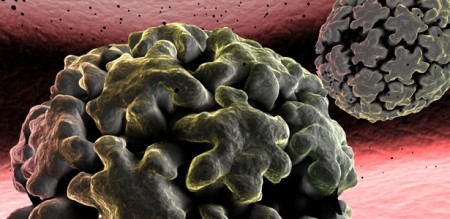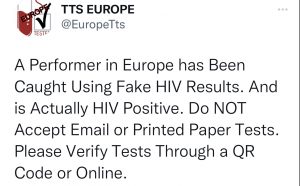It’s the typical culprit, but other factors, including immune changes, damage from nicotine, and even a genetic disposition, could play a part.
Earlier this month, the American Cancer Society (ACS) released its annual Cancer Facts & Figures. The 2012 report includes some encouraging facts. Since 1990, the incidence of some common tumors including lung, colon, and prostate cancer has declined. Meanwhile, the rate of seven malignancies, like those of the lower mouth and throat linked to human papillomavirus (HPV), is increasing. The cause of this trend, which many assume is linked to people engaging in more oral sex, is not as straightforward as you might think.
Oropharyngeal cancers refer to tumors of the tonsils and rear tongue, back of the palate and posterior walls of the throat. Like their anatomical neighbors — malignancies of the larynx, vocal cords, anterior and mid-tongue, other parts of the mouth and lips — oropharyngeal cancers arise more often in people who drink and smoke heavily. These other head and neck cancers have waned in recent years, probably because North Americans are smoking fewer cigarettes and chewing less tobacco.
The ACS estimates there will be 13,500 new cases of oropharyngeal cancer in the U.S. this year. This includes both HPV positive and negative cases; nearly 11,000 men and over 2,500 women will be affected; some 2,300 will succumb to this condition. Between 1999 and 2008, the rate of HPV positive oropharyngeal cancers by rose 4.4 percent per year in white men and by 1.9 percent per year in white women. Changes among other racial and ethnic groups were not significant, according to the report. The biggest rise emerged in men between the ages of 55 and 64 years.
“At Georgetown, we have patients in their 80s with this kind of cancer. That raises questions about the sexual habits of Americans who are older, or about HPV.”
“Like investigators elsewhere, we’re seeing an increased incidence of oropharyngeal cancer,” says Dr. John Deeken, a medical oncologist at Georgetown’s Lombardi Cancer Center. Cancer-causing HPV strains tend to infect immune cells at the base of the tongue and tonsils, Deeken explains. “This may be why we’re seeing the virus in tumors in those parts of the oropharynx, while the incidence of lip, larynx, and vocal cord cancers is not going up.” If the cancer were simply caused by infection with HPV upon sexual transmission there would be more cases in women, he considers.
“The epidemiology is perplexing,” he says. “The assumption, when we noticed the trend eight or nine years ago, was that this was a sexually transmitted disease due to more oral sex,” he says. “But at least at Georgetown, we have patients in their 80s with this kind of cancer,” he notes. “That raises questions about the sexual habits of Americans who are older, or about HPV.”
The latency period between initial HPV infection and cancer can last decades, confirms Dr. Maura L. Gillison, an oncologist and professor at Ohio State who has published seminal findings on HPV and cancer. Her group carried out a case control study, reported in the New England Journal of Medicine, revealing that individuals who’ve had more vaginal and oral sex partners in their lifetime have a higher risk of developing oropharyngeal cancer, and that HPV-16 infection correlates with this cancer type.
Human papillomavirus was one of the first viruses identified in human cancers. Approximately 40 subtypes spread sexually. Two types, HPV-16 and HPV-18, account for most cases of cervical cancer in the U.S. Most women with HPV are asymptomatic and don’t get cervical cancer; when and if malignancy develops, it’s usually 20, 30 years or longer after initial infection. Most often, oropharyngeal cancers are caused by the HPV-16 subtype.
“The mechanisms by which HPV causes cancer are pretty well-established,” Gillison says. Two viral genes, called E6 and E7, are implicated. The virus itself contains only a few genes; it can’t propagate apart from human cells. But once HPV has infected squamous cells like those lining the cervix, anus, or pharynx, E6 and E7 take over critical machinery that control processes like DNA repair, cell cycle, and maturation, she explains. Because the virus interferes with signals that normally regulate cell growth, HPV-infected cells tend to survive and replicate.
The E6 and E7 proteins, encoded by the genes, are necessary but not sufficient for cancer formation, Gillison considers. As is the case for HPV infection in the genitals, most individuals infected with HPV in the mouth don’t develop tumors. The key question is what other factors — like damage to the oral cavity from nicotine or other toxins, immune changes, or possibly a genetic disposition — lead to oropharyngeal tumors in some people, typically years after the initial infection.
For patients with oropharyngeal cancer linked to HPV, the prognosis is relatively good. “We’re seeing higher cure rates with HPV cancers than for other head and neck cancers,” Deeken says. “The patients tend to respond more readily and completely to treatment no matter what we give them, whether it’s chemo or radiation.”
“The ideal would be to prevent HPV infection in the first place,” Gillison says. The FDA has approved two HPV vaccines, Gardasil and Cervarix, for primary prevention of cervical cancer. The rationale for that indication is that by immunizing a girl or young woman against HPV, she’s less likely to develop cervical cancer caused by the virus. The same strategy should work for preventing viral infection and cancer in the oropharynx, according to Gillison.
Gardasil, a vaccine that covers four HPV subtypes, has been approved for boys to prevent genital warts and anal cancer. Still, the FDA hasn’t recommended routine vaccination of boys or young men against HPV. In Octobee 2011 the CDC’s Advisory Committee on Immunization Practices reviewed current data and advised that most boys be vaccinated with Gardasil.
“We’ve identified a new cause of a cancer that was previously unrecognized in a group of people that are largely men who are not getting vaccinated for HPV at the moment,” Gillison says. “As someone who practices evidence-based medicine, I’m not comfortable assuming it would work.” But there’s no adequate trial ongoing, she says. “It’s ridiculous that we’re not willing to look at whether a vaccine works. That’s the best approach to change the incidence of this cancer.”
Deeken also supports a primary prevention, by vaccination of young people against HPV. “Hopefully in decades ahead, teenagers who are getting vaccinated now will not be developing oropharyngeal cancer,” he says. “But that will be hard to prove, and it will take a long time.”
From The Atlantic
Image: MichaelTaylor/Shutterstock.







